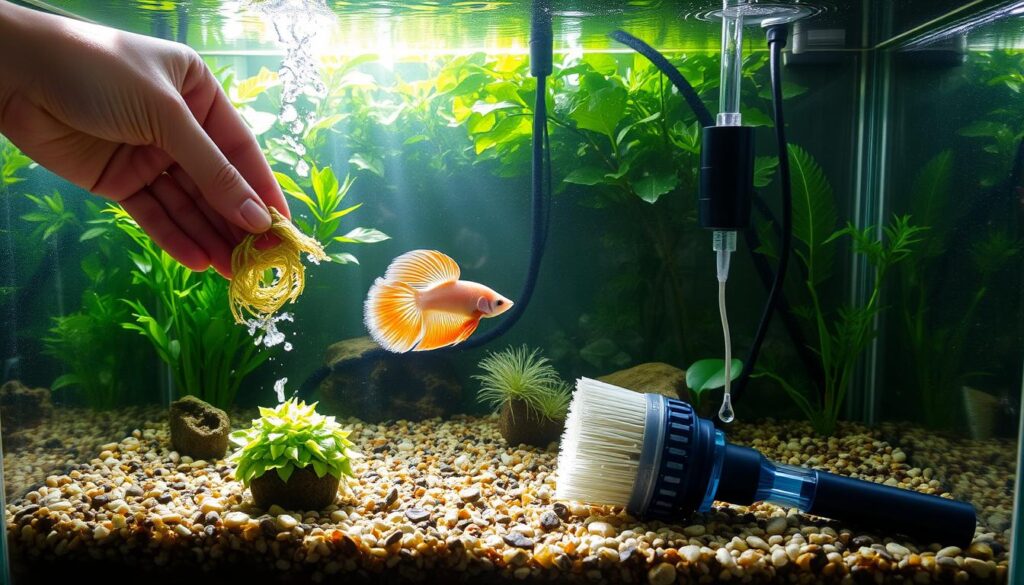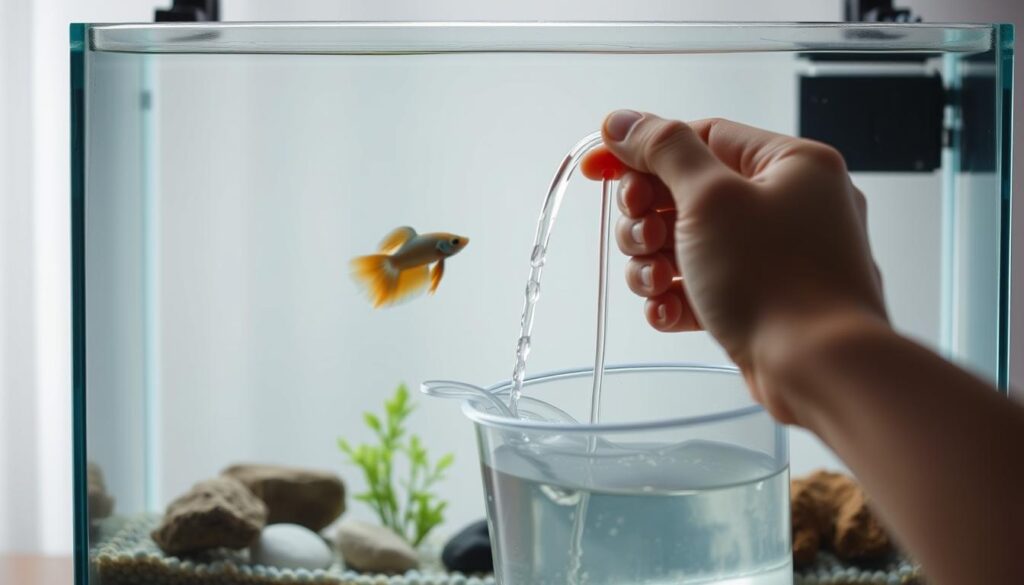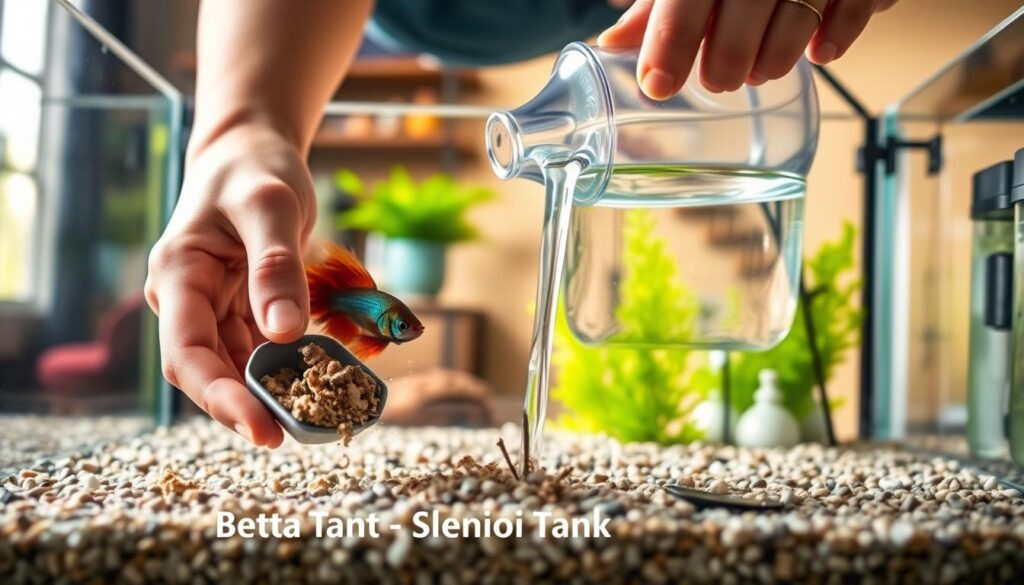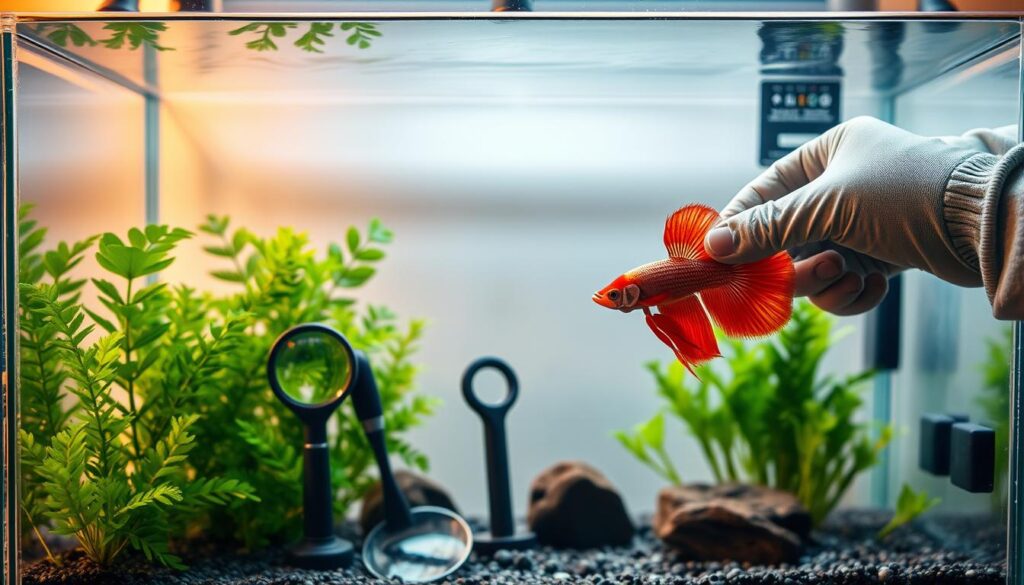Are you a new betta fish owner wondering how to clean a betta fish tank for beginners without harming your fish? Keeping your betta’s tank clean is one of the most important steps to ensure a healthy and stress-free life for your finned friend. In this beginner-friendly guide, we’ll walk you through simple and safe steps to clean your tank, even if it’s your first time.
Keeping your betta fish happy and healthy is key. It all starts with a clean and well-maintained tank! As a beginner, it’s normal to feel a bit overwhelmed. But, don’t worry, we’ve got you covered!
Maintaining a clean tank is vital for your betta’s well-being. A dirty tank can cause stress, disease, and even death. But, with the right guidance, you’ll become a pro in no time! Let’s explore the simple steps to keep your tank sparkling clean.
Key Takeaways
- Understand the importance of regular tank cleaning for your betta’s health.
- Learn the simple steps to clean your betta fish tank.
- Discover tips for maintaining a healthy environment for your betta.
- Find out how to avoid common mistakes when cleaning your betta’s tank.
- Get started with our step-by-step guide to betta fish tank cleaning.
Understanding Your Betta’s Habitat Needs
Creating a great home for your betta starts with knowing what they need. A clean tank is more than just cleanliness. It’s about making a space that keeps your betta healthy and happy.
Ideal Tank Size and Setup for Healthy Bettas
Tank size is key to keeping your betta healthy. A tank of at least 5 gallons is best. This size gives your betta enough room to swim and grow well. Avoid small bowls or tanks under 5 gallons, as they can harm your betta’s health.
For the best setup, add plants, decorations, and a heater. This helps keep the water at a stable temperature between 76-82°F (24-28°C).
The Critical Role of Water Quality in Betta Health
Water quality is vital for your betta’s health. Bad water can stress, disease, and even kill your betta. It’s important to change the water regularly and check its quality.
Use a water conditioner to remove harmful chemicals. Also, watch the pH and ammonia levels closely.
How Dirty Tanks Affect Betta Behavior and Lifespan
A dirty tank can harm your betta’s behavior and lifespan. Bad water can make your betta stressed, leading to sickness and a short life. Keeping the tank clean is crucial to prevent these problems.
By understanding and meeting your betta’s habitat needs, you’ll create a happy, healthy home. Easy betta fish tank maintenance is about balancing the environment for your betta’s well-being.
Read Also Black Beard Algae Flourish Excel: Tips to Boost Growth and Health
Essential Supplies for Betta Tank Cleaning
Before you start cleaning your betta’s tank, let’s get you equipped with the right supplies! Having the right tools is key for effective tank cleaning. You’ll need a few must-haves to keep your betta’s home clean and healthy.
Must-Have Cleaning Tools and Equipment
To start, you’ll need a gravel vacuum to remove debris from the substrate. A soft-bristled brush is also necessary for gently cleaning decorations and glass walls. Don’t forget a water test kit to ensure your water parameters are safe for your betta!
- A gravel vacuum or siphon hose
- A soft-bristled brush or algae scrubber
- A water test kit
- A clean bucket for water changes
Water Conditioners and Treatment Products
Water conditioners are crucial for removing chlorine and chloramines from tap water, making it safe for your betta. Look for a reputable water conditioner that can handle your tank’s volume.
Eco-Friendly Cleaning Alternatives
For those who prefer a more natural approach, consider using eco-friendly cleaning products that are safe for your betta and the environment. Some popular alternatives include vinegar and baking soda.
Preparing for Your First Tank Cleaning
Cleaning your betta’s tank can seem tough, but we’re here to help! You want to keep your betta’s home clean and healthy. Before you start cleaning, you’ll need to get a few things ready.
Creating a Safe Cleaning Station
First, set up a safe cleaning area. You’ll need a clean, flat surface for your tank and cleaning supplies. Keep it away from distractions or hazards, like kids or pets! A clean workspace is indeed a happy one.
Water Preparation and Aging Techniques
Next, prepare the water for your betta’s tank. Use dechlorinated water that’s aged to match your tank’s temperature. Fill a separate container with tap water and let it sit for 24 hours. This step helps prevent shocking your betta with sudden changes.
Temporary Housing Options During Cleaning
While cleaning, your betta needs a temporary home. Use a separate container filled with tank water. Make sure it’s safe and comfortable for your betta. Keep the container covered to prevent jumping and maintain the same water temperature to reduce stress.
How to Clean a Betta Fish Tank for Beginners: Step-by-Step Guide
Ready to give your betta a cleaner home? Here’s a step-by-step guide! Cleaning your betta fish tank might seem daunting, but with the right steps, you’ll be a pro in no time. Let’s dive into the proper betta tank cleaning process to keep your betta healthy and happy.
Pre-Cleaning Safety Checklist
Before you start, make sure you’ve got everything you need. Here’s a quick checklist:
- Clean bucket for water changes
- Gravel vacuum
- Soft-bristled brush for decorations
- Water conditioner
- A clean, betta-safe container for temporary housing
Proper Betta Removal and Handling Techniques
Gently remove your betta from the tank using a soft net. Make sure to handle them carefully to avoid stressing or injuring your fish. Place your betta in a clean, pre-conditioned water container to keep them safe while you clean their home.

Systematic Water Removal Process
Start by removing about 25-50% of the tank water. Use a gravel vacuum to clean the substrate and remove debris. This step is crucial for maintaining good water quality.
| Water Removal Percentage | Frequency | Benefits |
|---|---|---|
| 25% | Weekly | Maintains water quality, reduces algae growth |
| 50% | Bi-Weekly | Deep cleans the tank, improves betta health |
Thorough Cleaning of Tank Surfaces and Decorations
Use a soft-bristled brush to gently scrub away algae from tank walls and decorations. Rinse any decorations in the removed tank water to avoid killing beneficial bacteria. Make sure to clean the filter according to the manufacturer’s instructions.
By following these essential tips for betta tank cleaning, you’ll ensure your betta lives in a clean, healthy environment. Happy cleaning!
Read Also Top 10 Black Beard Algae Eaters for a Clean Aquarium (2025 Guide)
Cleaning Different Types of Betta Tank Equipment
Let’s get into the details of cleaning betta tank equipment. You want your betta’s home to be clean and well-kept, right?
Filter Maintenance Without Destroying Beneficial Bacteria
Your filter is key to your betta’s tank. Clean it gently to keep beneficial bacteria alive. Rinse the filter media in old tank water, not tap water. A rinse every 2-4 weeks is usually enough.
Gravel Vacuum and Substrate Cleaning Methods
Cleaning the gravel and substrate is vital for water quality. Use a gravel vacuum to remove waste. Stir the gravel gently to release more waste.
| Equipment | Cleaning Method | Frequency |
|---|---|---|
| Filter | Rinse in old tank water | Every 2-4 weeks |
| Gravel/Substrate | Gravel vacuum and stir | Weekly |
| Live Plants | Trim dead leaves, rinse gently | As needed |
Proper Care for Live Plants vs. Artificial Decorations
Live plants need more care than artificial ones. Trim dead leaves and rinse them gently. Artificial decorations can be cleaned with a soft-bristled brush or a rinse in old tank water.
Safely Cleaning Heaters, Thermometers, and Other Equipment
Always unplug heaters, thermometers, and other equipment before cleaning. Use a soft-bristled brush or a magnetic algae scraper. Avoid harsh chemicals or abrasive materials that can harm the equipment.
By following these tips, you’ll keep your betta’s tank equipment clean. This ensures a healthy and happy home for your betta!
Proper Water Change Procedures
Water changes are key for betta tank care. They remove waste and excess nutrients that cause algae. This keeps your betta healthy.
When to Do Partial vs. Complete Water Changes
For most betta tanks, change 25-50% of the water weekly. But, a full change might be needed for new tanks or bad water quality. Always acclimate your betta to avoid shock.
Matching Water Parameters: Temperature, pH, and Hardness
To keep your betta happy, match the new water to the tank’s conditions. Use a thermometer for temperature and a test kit for pH and hardness. If unsure, make small adjustments.

The Correct Method for Adding Fresh Water to the Tank
Use a gravel vacuum to clean the substrate before adding new water. Pour it in gently. Add a water conditioner to remove chlorine and stabilize the water. Add the water slowly to avoid stressing your betta.
Establishing a Betta Tank Cleaning Schedule
A clean tank means a happy fish. Let’s create a cleaning schedule for your betta tank. Regular cleaning keeps your tank healthy and your betta happy.
Daily Maintenance Quick Checks
Every day, do quick checks. Make sure the water level is right and top it off if needed. Also, watch your betta’s behavior and look for any changes.
Weekly Cleaning Routine for Optimal Health
Once a week, do a partial water change (25-50% of the tank). Use a gravel vacuum to clean the substrate. Clean the glass walls too. This keeps the water quality high and your tank looking great.
Read Also Betta Fish Stress Stripes: What They Mean and How to Treat Them
Monthly Deep Clean Process and Equipment Inspection
Once a month, do a deep clean. Move your betta to a safe place. Then, remove decorations and equipment for cleaning. Check all equipment to make sure it’s working right and replace any broken parts.
| Frequency | Task |
|---|---|
| Daily | Check water level, observe betta’s behavior |
| Weekly | Partial water change, gravel vacuum, clean glass |
| Monthly | Deep clean tank, inspect and clean equipment |
Stick to this schedule and your betta tank will stay clean. Your fish will be healthy and happy. Happy cleaning!
Common Betta Tank Cleaning Mistakes to Avoid
Cleaning your betta’s tank can be tricky, but with the right tips, you’ll get it right. It’s easy to make mistakes, but we’ll show you how to avoid them. This way, you can clean your tank well without hurting your betta.
Overcleaning: Preserving the Beneficial Bacterial Colony
One big mistake is overcleaning your betta’s tank. This messes up the good bacteria that keep your tank healthy. To avoid this, clean your tank gently. Only replace a bit of water at a time.
Dangerous Household Products to Never Use
When cleaning your betta’s tank, stay away from harmful household products. Don’t use bleach, soap, or other harsh chemicals. They can be toxic to your betta. Instead, choose gentle, aquarium-specific cleaning products.
Preventing Temperature and pH Shock During Cleaning
Temperature and pH shock can harm your betta. To prevent this, make sure the new water matches the existing water’s temperature and pH. Use a thermometer and pH test kit to do this.
| Common Mistakes | Consequences | Prevention |
|---|---|---|
| Overcleaning | Disrupts beneficial bacteria | Clean in moderation |
| Using household products | Toxic to betta | Use aquarium-specific products |
| Temperature and pH shock | Stress or kill betta | Match temperature and pH |
By knowing these common mistakes and how to avoid them, you’ll create a healthy home for your betta.

Monitoring Water Quality Between Cleanings
The health of your betta fish depends on the water quality. Let’s look at how to keep it clean! Regular water testing is key for good water quality. You should do it often between cleanings.
Essential Water Parameters to Test Regularly
To keep your betta healthy, monitor several water parameters. These include:
- pH levels
- Ammonia and nitrite levels
- Nitrate levels
- Water hardness
- Temperature
Use a water test kit to check these parameters at home. It’s easy and can greatly improve your betta’s health!
| Parameter | Ideal Range | Action if Out of Range |
|---|---|---|
| pH | 6.5-8.5 | Adjust pH slowly to avoid shocking your betta |
| Ammonia | 0 ppm | Perform immediate water change |
| Nitrite | 0 ppm | Perform immediate water change |
| Nitrate | <20 ppm | Perform partial water change |
Visual and Behavioral Signs of Poor Water Quality
Besides regular testing, watch for signs of poor water quality. These include:
- Cloudy or discolored water
- Algae growth
- Your betta gasping at the surface
- Lethargy or loss of appetite
Emergency Water Treatments for Sudden Issues
Sometimes, water quality can suddenly get worse. Knowing how to act quickly can save your betta. For example, if ammonia or nitrite levels spike, do an immediate water change. Water conditioners can also help neutralize toxins.
Remember: It’s better to prevent problems than to fix them. Regular monitoring and care can stop many water quality issues.
By following these tips and staying alert, you can keep your betta in a healthy environment. Happy aquarium keeping!
Adapting Cleaning Routines for Different Tank Setups
Cleaning your betta’s tank needs a tailored approach. Different setups, like small tanks or community tanks, require unique cleaning methods. Understanding these differences is crucial for your betta’s health and happiness.
Small Tanks vs. Larger Aquariums: Cleaning Differences
Small tanks, under 5 gallons, need more frequent water changes. Larger tanks can go longer but require deeper cleaning. For small tanks, be precise and gentle to avoid stressing your betta.

Planted Tank Special Considerations
Planted tanks add complexity to cleaning. Live plants improve water quality but need care. Be gentle around plants and consider their needs during water changes.
Community Tank Cleaning When Bettas Have Tankmates
Community tanks need extra care during cleaning. This is to avoid stressing your betta and its tankmates. Keep a close eye on water parameters and adjust your cleaning schedule as needed.
| Tank Type | Cleaning Frequency | Special Considerations |
|---|---|---|
| Small Tanks | More frequent water changes | Gentle cleaning to avoid stressing betta |
| Planted Tanks | Consider plant needs during water changes | Gentle around plants, monitor water parameters |
| Community Tanks | Monitor all inhabitants, adjust cleaning schedule as needed | Avoid stressing betta and tankmates, close monitoring of water parameters |
By tailoring your cleaning routine to your tank’s needs, you’ll create a great environment for your betta. Happy cleaning!
Troubleshooting Common Betta Tank Problems
Betta tanks can sometimes face challenges, but we’re here to help. Troubleshooting is crucial for any betta owner. We’ll guide you through common issues you might face.
Combating Different Types of Algae Growth
Algae can be a problem in your betta’s tank. Knowing the type of algae is key to fighting it. Green algae is common and can be managed by adjusting lighting and nutrients. Black beard algae is tougher and might need special treatments.
| Type of Algae | Causes | Solutions |
|---|---|---|
| Green Algae | Excessive lighting, high nutrient levels | Reduce lighting, adjust nutrient levels |
| Black Beard Algae | Poor water circulation, excessive nutrients | Improve water circulation, use specific algae treatments |
Addressing Persistent Cloudy Water Issues
Cloudy water is alarming but often fixable. First, check your filtration system. Regular water changes and monitoring your tank’s parameters can also help.
Managing Dangerous Ammonia and Nitrite Spikes
Ammonia and nitrite spikes are serious threats to your betta’s health. Regular water testing is essential. Immediate water changes can help. Make sure your tank is fully cycled before adding your betta. Consider using beneficial bacteria supplements to keep your tank stable.
When and How to Seek Professional Aquarium Help
At times, you might need professional help. If you can’t solve problems with troubleshooting, or if your betta is sick, seek an expert. Look for local pet stores with knowledgeable staff or online forums with experienced aquarists.
By staying vigilant and addressing issues quickly, you can keep your betta tank healthy. Remember, clean betta fish tank tutorial guidelines are just a starting point. Ongoing care and troubleshooting are essential for a happy, healthy betta.
Conclusion
Now you know how to clean a betta fish tank for beginners. It’s time to start using these tips for cleaning your betta’s tank. Keeping their home clean is just the start. Regular care and watching your betta will keep them healthy and happy.
By following this guide, you’re on your way to a great home for your betta. It might take some time to get it right, but with practice, you’ll be a pro. You’ll keep your tank clean and your betta healthy!
Remember, every tank is different. Be ready to make changes as needed. Don’t be afraid to ask for advice from more experienced fish keepers. With patience, detail, and a desire to learn, you’ll soon have a beautiful, thriving betta tank!


Nice blog here! Also your web site loads up very fast! What web host are you using?
Can I get your affiliate link to your host? I wish my site loaded up as quickly as
yours lol
Thank you so much! I really appreciate your kind words and I’m glad you enjoyed the blog. 😊 Yes, site speed is something I focus on a lot. I’m currently using a reliable hosting setup that helps keep the website fast and smooth. I’ll be happy to share the hosting details and affiliate link with you — please check your email or feel free to reach out via the contact page. Thanks again for your support!